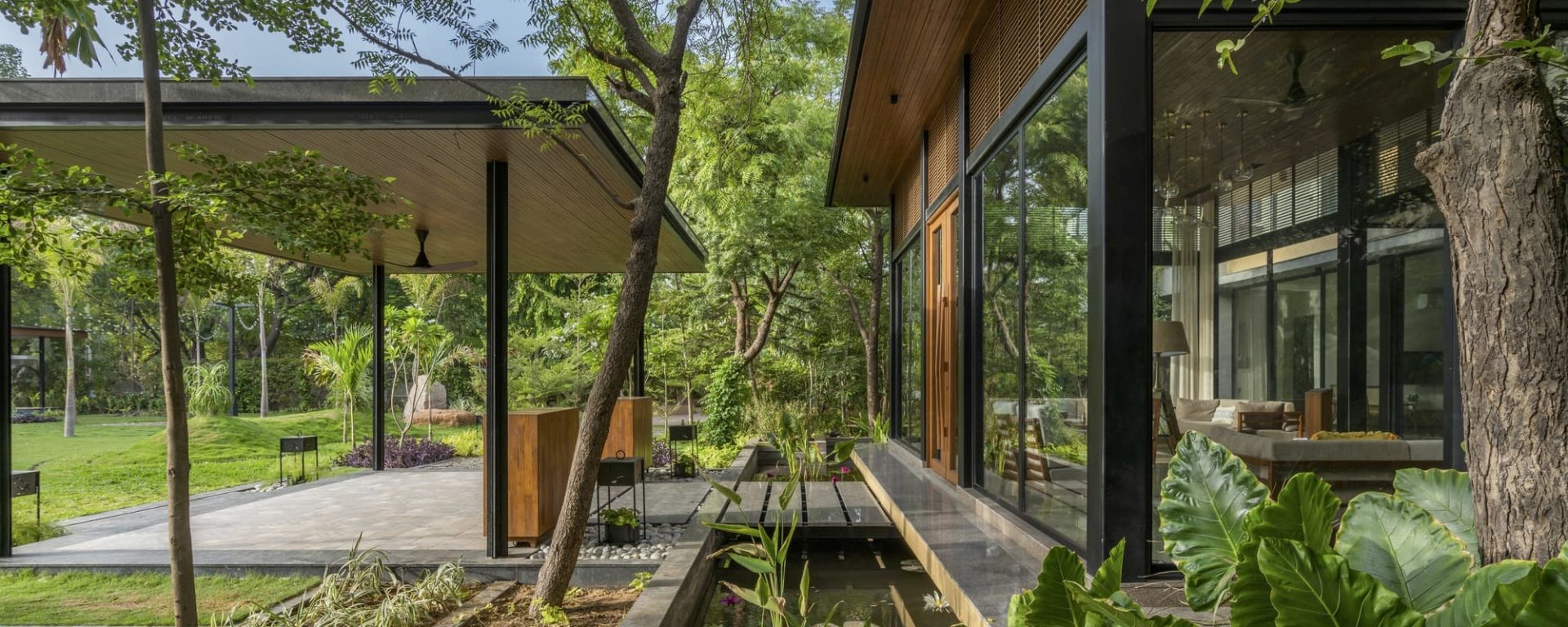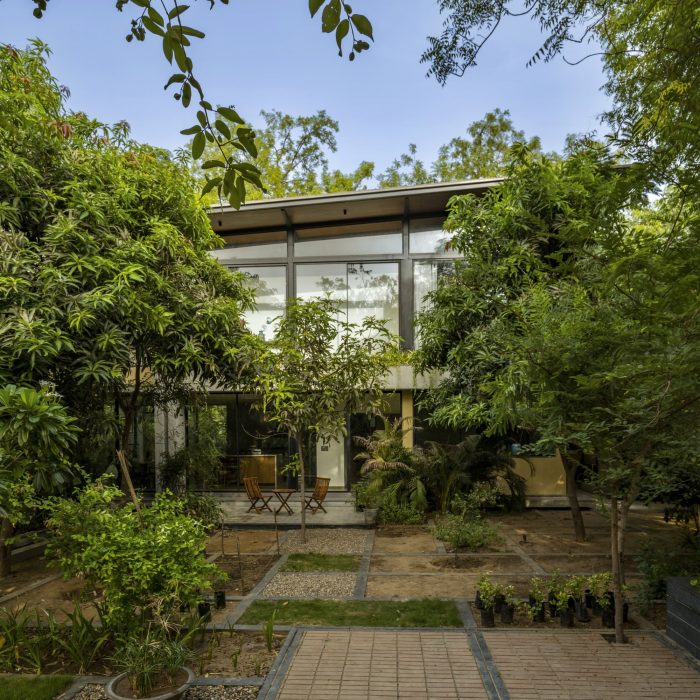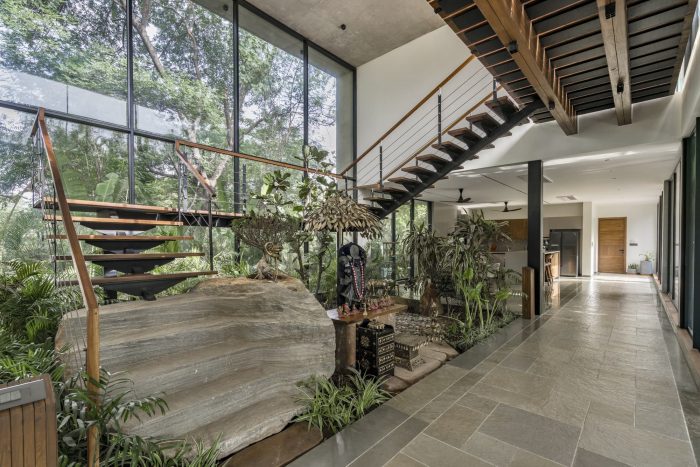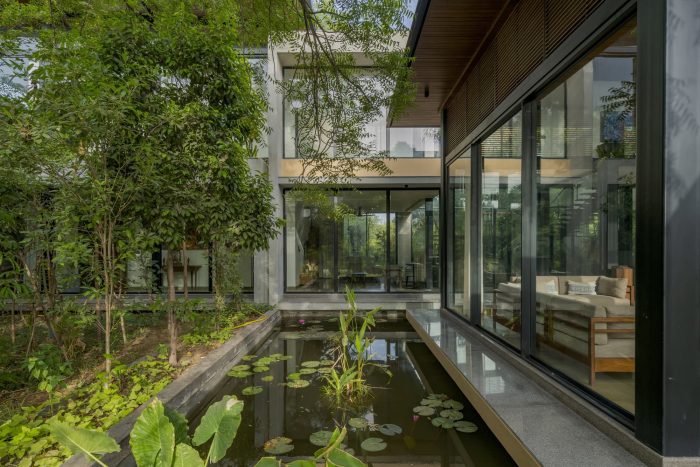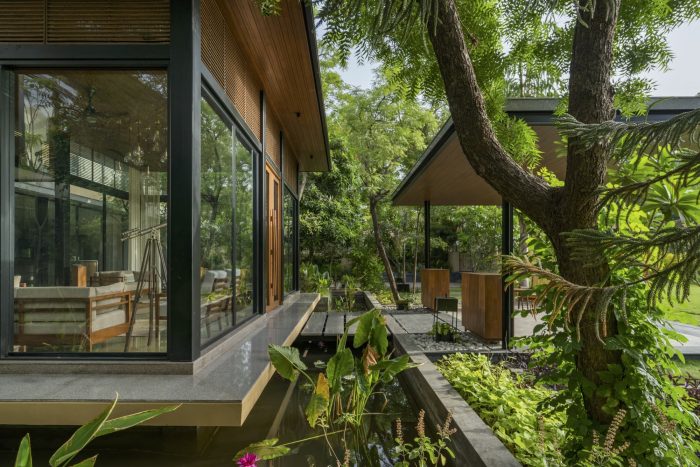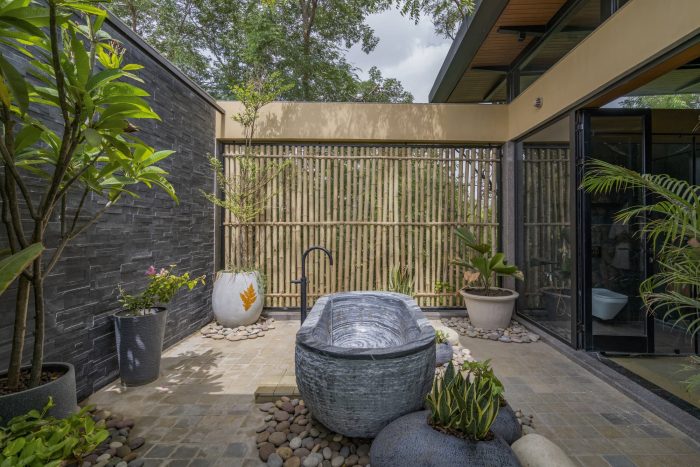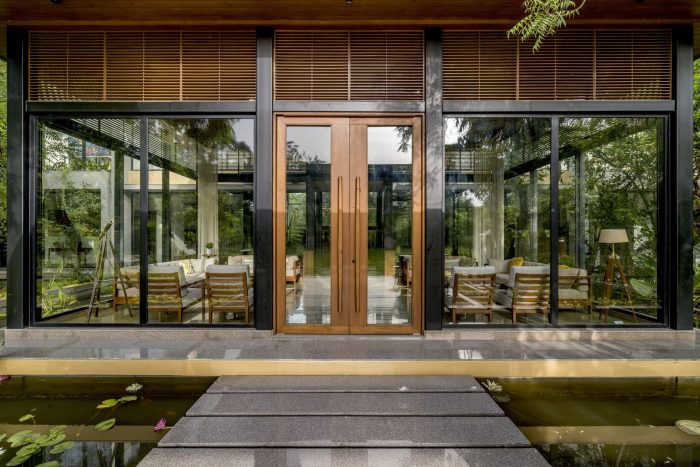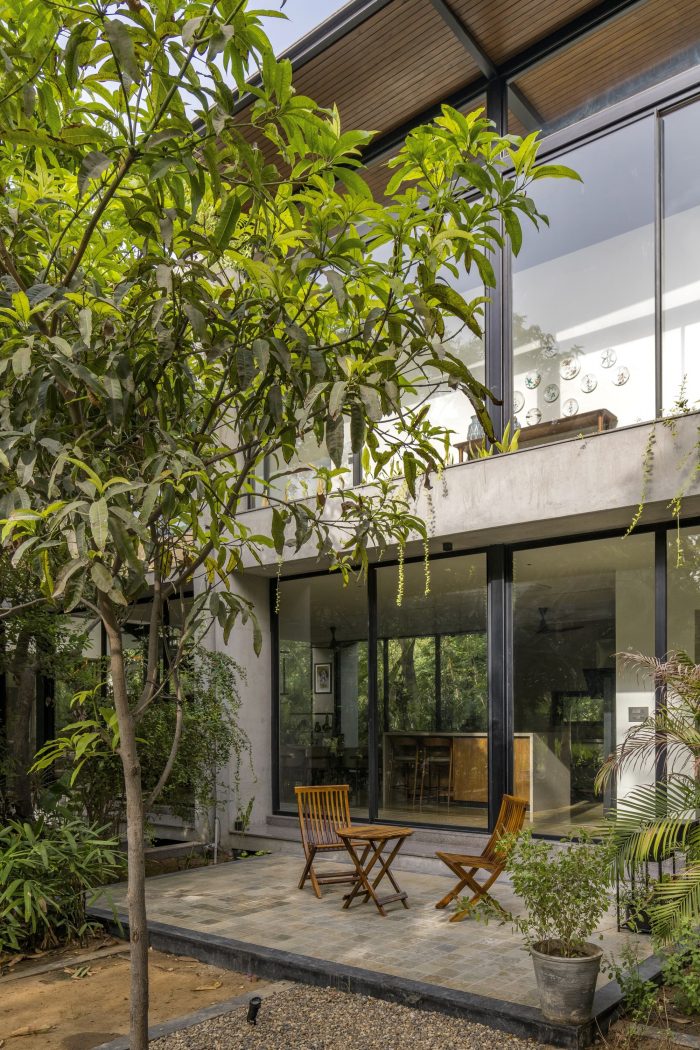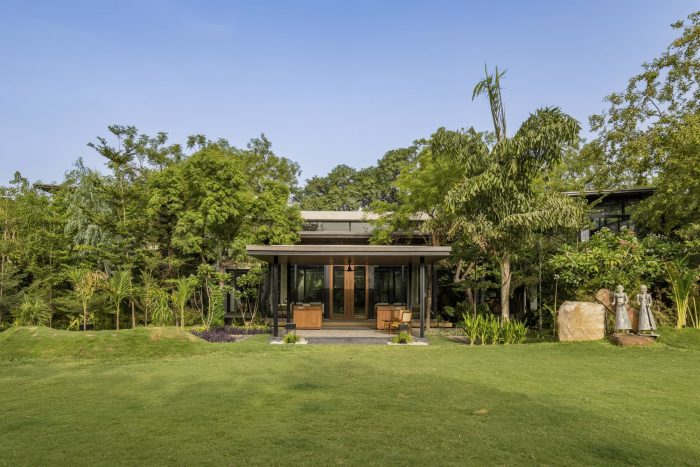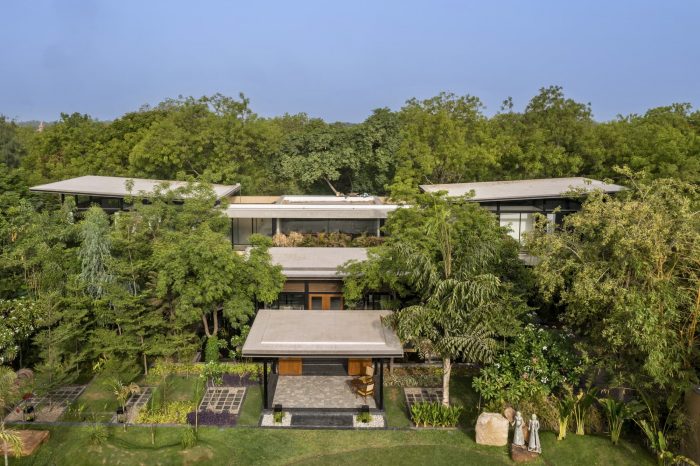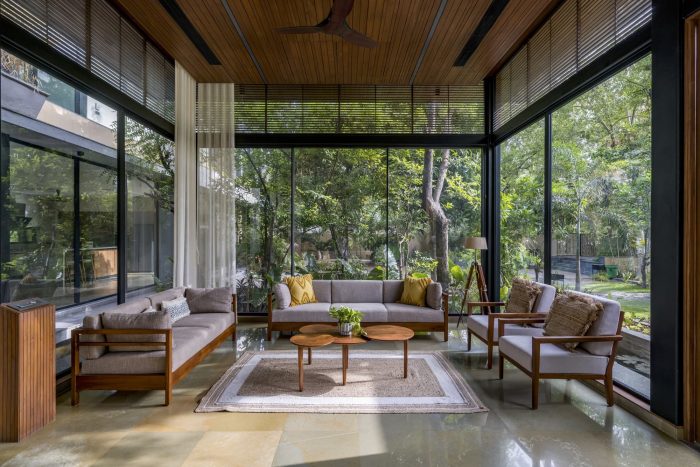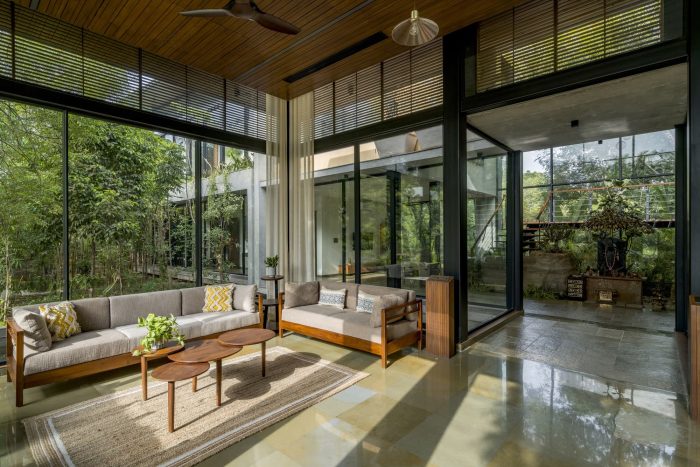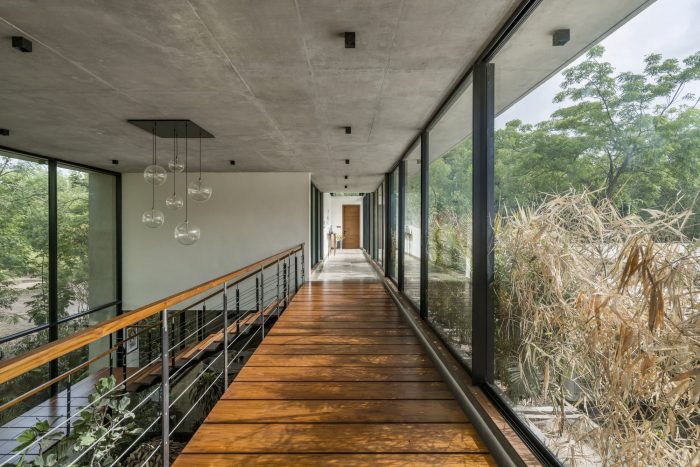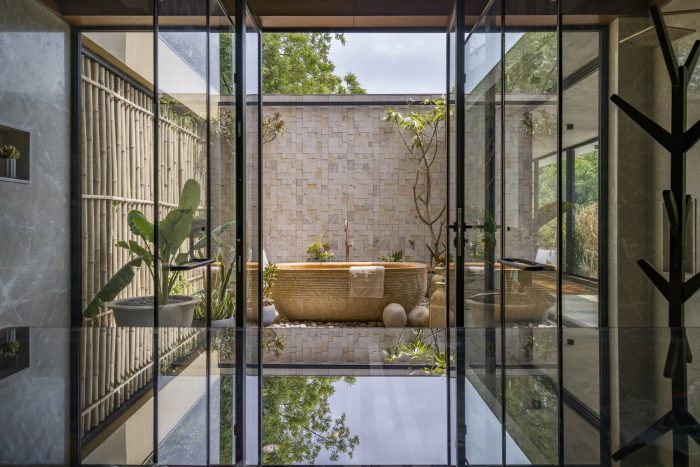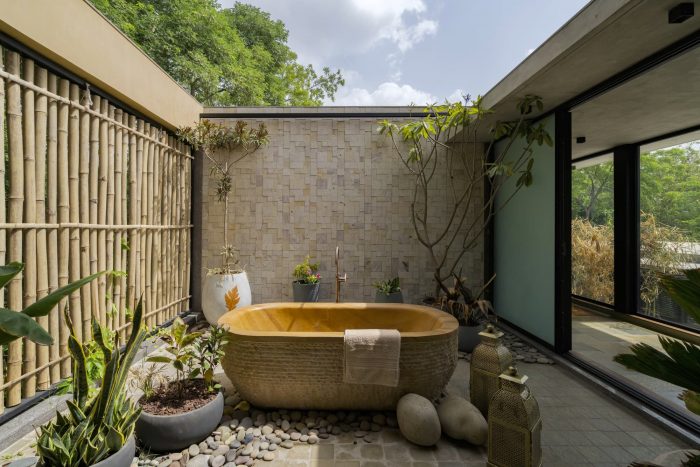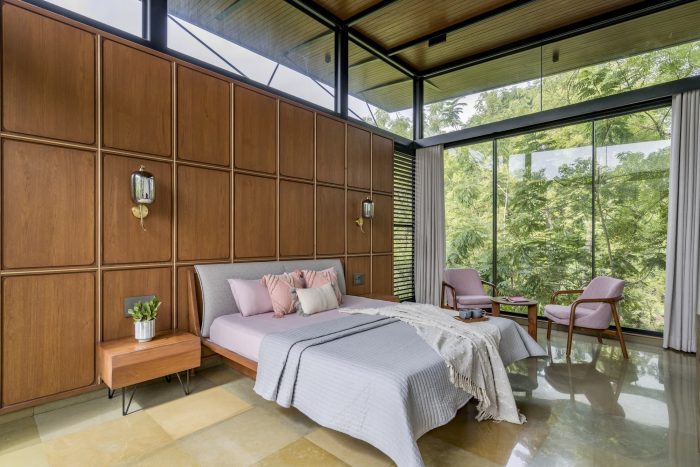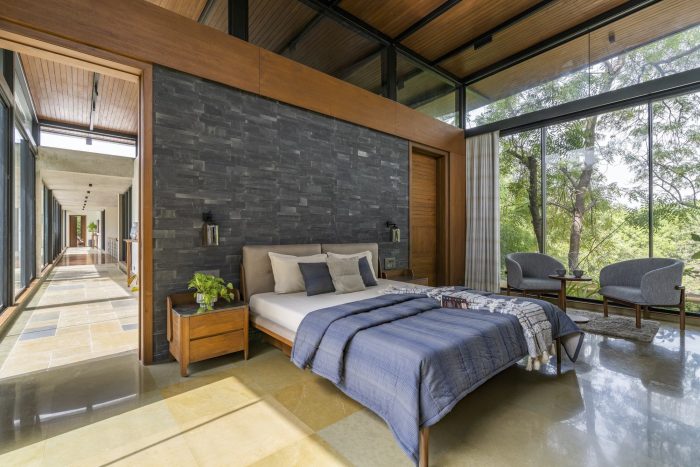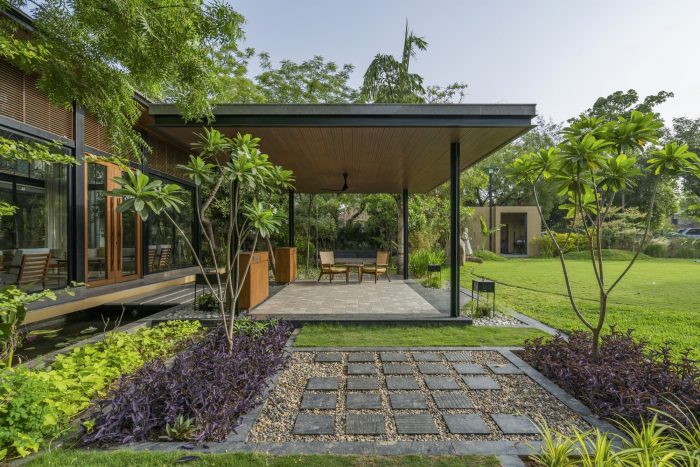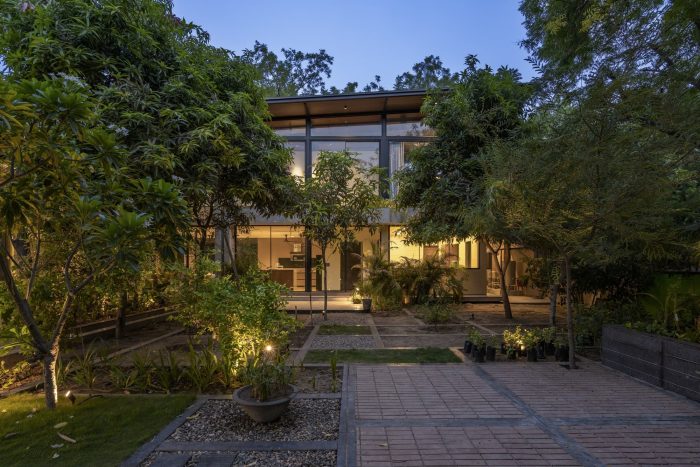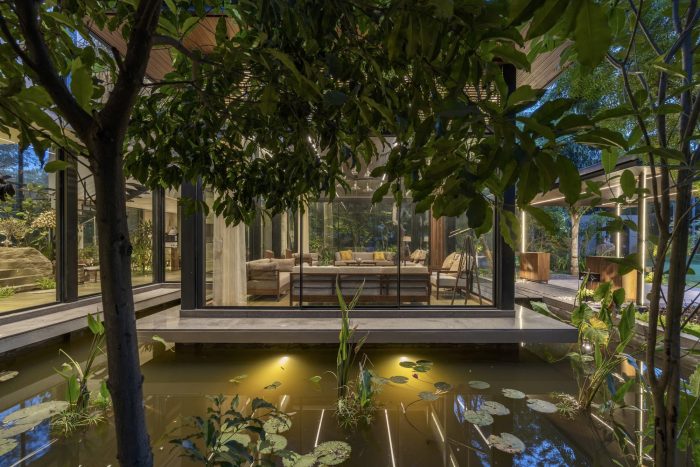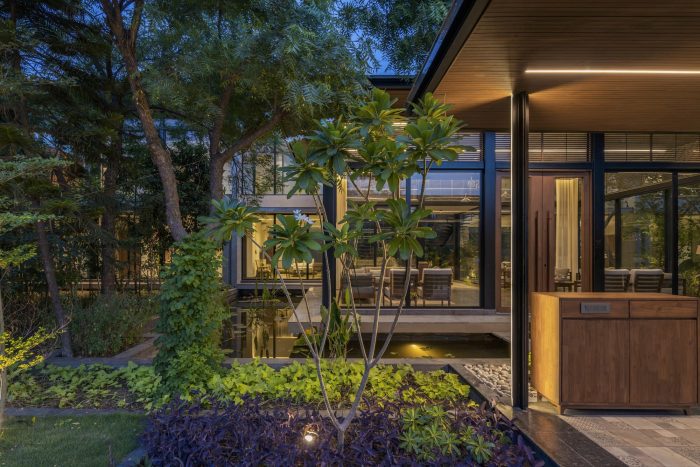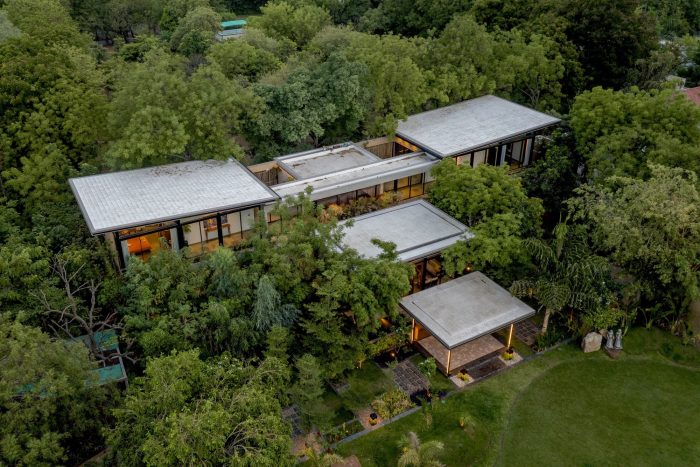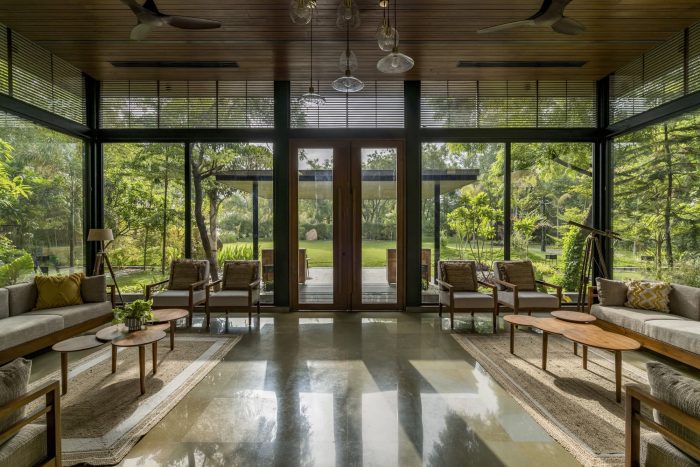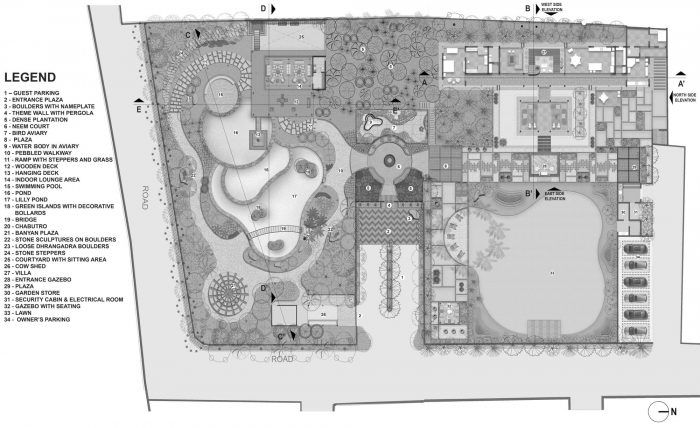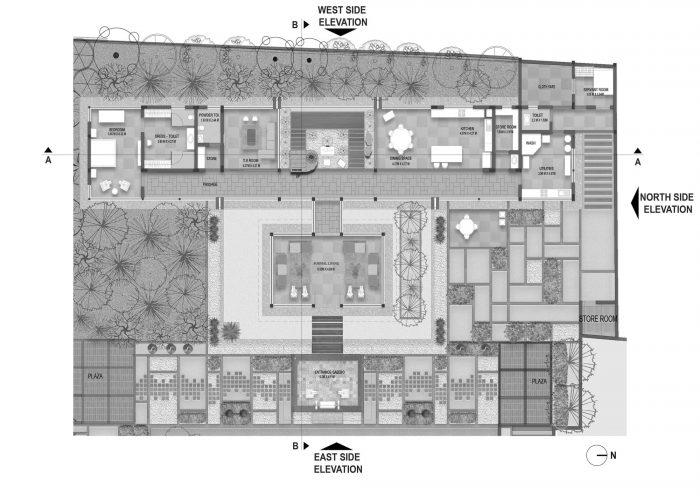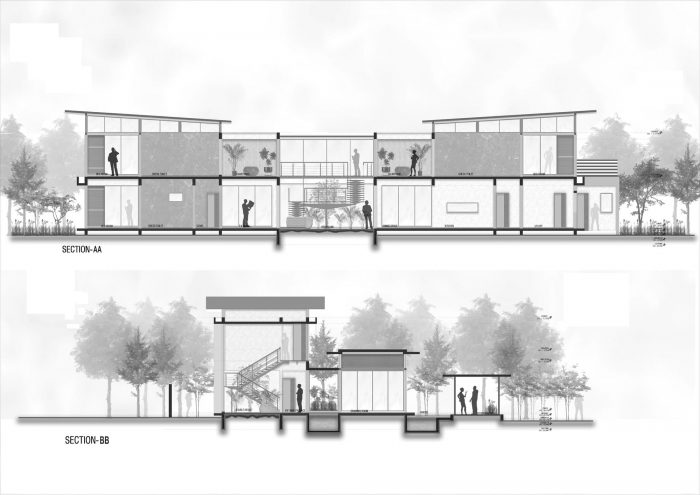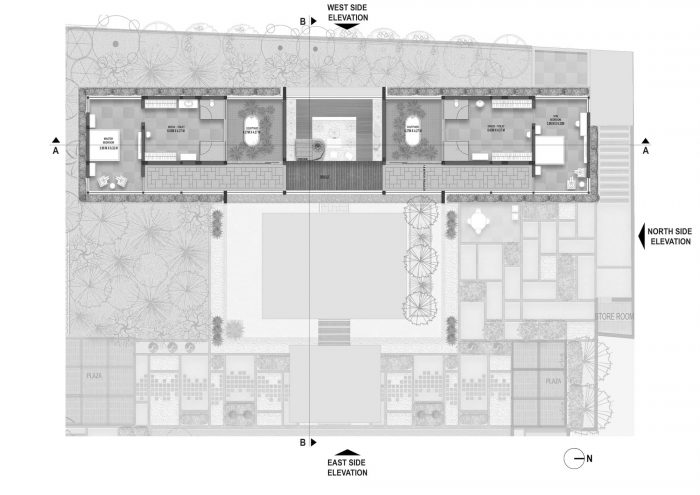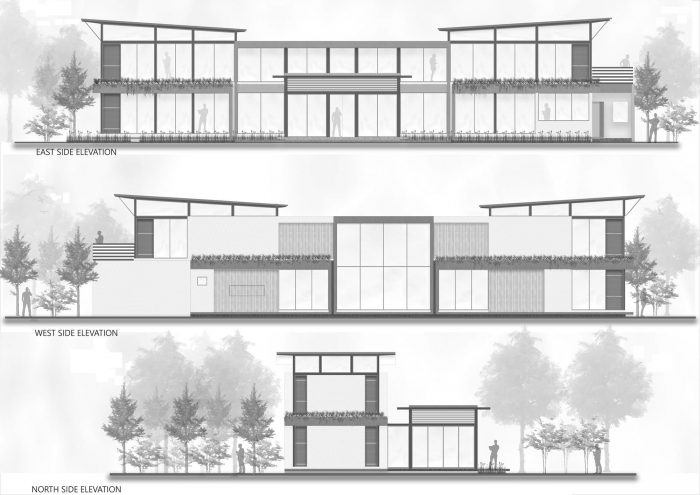Kalrav是人类和鸟类的栖息地;Kalrav的房子,被翻译为鸣叫的鸟的房子,坐落在以前存在的和新抽出的树木丛中。面向东方,Kalrav(外墙)以 “飞鸟 “的形式打开。根据房子的位置,其目的是尽可能减少房子的占地面积。其形式是用玻璃作为外墙,由裸露的混凝土和石灰石膏支撑,以炫耀最小的、光滑的和朴实的设计。人们从低矮高大的入口亭子进入房子,展开两个高架的座位室–私人的和正式的–被水体包围着,从而形成一个浮动的岛屿的氛围。
An abode to humans and birds alike; Kalrav house, which translates to the house of chirping birds, is nested within a thicket of previously existing and newly sapped trees. Facing the east, Kalrav (façade) opens up in the form of a ‘flying bird’. Following the position of the house, the intent is the least possible footprint taken up by the house. The form is shaped with glass as a façade supported by exposed concrete and lime plaster to flaunt the minimal, sleek, and earthy design. One is welcomed by the low heightened entrance pavilion into the house which unfolds two elevated seating rooms – private and formal- encompassed by water bodies, thus forming the ambiance of a floating island.
此外,这些岛屿揭示了一个中央的双高楼梯井,笼罩着景观,并模糊了这个住所的内部和外部的关系。最初的台阶被设计成 “dhangadhara(当地)石头 “的雕刻,相当的楼梯跋涉。在往上走的时候,楼梯采用了当地柚木和钢架的圆滑形式。这个院子被开放的 “Mandir “空间所提升。祈祷室经过深思熟虑的设计,被院子周围的景观所包围。与其将神灵禁锢在墙内,不如将它们建立在更透气的广场上。在这个宏伟的庭院的一侧是半私人的空间,厨房、餐厅、公用设施空间等等。而另一边则是私人空间,包括角落里的卧室和家庭座椅。
Further, these islands reveal a central, double-height stair shaft enveloping the landscape, and blurring the inside-outside of this abode. The initial steps are designed as carvings of ‘dhangadhara (local) stone’, quite a stair trek. While stepping up, stairs take sleek form from local teak wood and steel frame. This courtyard is elevated by the open ‘mandir’ space. The prayer room is thoughtfully designed to be surrounded by the landscape around the courtyard. Instead of confining the deities within walls, they’re established in the more breathable square. On one side of this magnificent courtyard lie the semi-private spaces, the kitchen, dining, utility spaces, and so on. Whereas, the other side is private spaces including a bedroom at the corner and family seating.
朝东的玻璃通道可以看到前面的花园,将令人振奋的绿色景观包裹在房子里。覆盖着玻璃的通道和阳台允许最大限度地参与周围的自然。在通道允许的如画的景色之后,是两个主卧室。主卧室有一个微妙的大地色调和组成的装饰,由石灰石膏和中性内饰组成。此外,这些主卧室被屋顶的设计所提升,它不仅形成了 “飞鸟 “的立面,而且有助于创造一种向上(漂浮)的氛围。再一次,玻璃和金属墙面的光滑度以及暴露的RCC作为救援,在这些卧室的背景中,以郁郁葱葱的绿色植物为背景,对这些卧室进行装饰。
An east-facing glass passage viewing the front garden encases the invigorating green landscape into the house. Glass-covered passages and balconies allow maximum involvement with nature around. Succeeding the picturesque view allowed by the passage lie two master bedrooms. Master bedrooms have a subtle underline of earthy tones and composed decorum furnished by lime plaster and neutral interiors. Besides, these master bedrooms are elevated by the design of the roof which, not only forms ‘the flying bird’ façade but helps create an uplifted (floating) aura. Once more, the sleekness of glass and metal walls along with exposed RCC act as the rescue in accessorizing these bedrooms with the presence of the lush greenery as a backdrop.
浮动屋顶的高度为1.5米,是一个钢制甲板结构,上面有一个混凝土层。它的顶部是由瓷砖进一步完成的,并以木材作为天花板的保温层。木质天花板给人以柔软和温暖的感觉。开放式浴室的概念被诱导出来,并对隐私给予最大的重视。定制的浴缸是用当地的石头(分别是拉贾斯坦石和黑石)做成的,后面是干式包覆的石墙。可透光的竹制屏风和绿色植物提供了一个柔和舒缓的氛围。敞开式的浴室被添加的景观家具所点缀。这个住宅的大部分都是玻璃幕墙,其设计考虑到了气候反应。这座房子是一个人的巢穴,一年四季都被最大限度的树叶所包围,从而保持了平衡的温度。水体和当地材料进一步帮助保持新鲜度。卧室等私人空间有 “科塔石 “地板和制作的百叶窗来控制自然光。
The floating roofs are elevated at 1.5 height and are a steel deck construction with a concrete layer atop. It is further finished by tiles on top and with thermal insulation finished with timber wood as the ceiling. The timber ceilings impart a soft and warm feeling throughout. The concept of an open bath is induced with utmost importance given to privacy. Custom bathtubs are fashioned out of local stones (Rajasthan stone and black stone respectively) back dropped with a dry-clad stone wall. The bamboo screens permeable to the light and greenery provide a soft and soothing aura. The open-to-sky bathrooms are adorned with added landscape furniture. A glass façade that skins the majority of this abode is designed by keeping climatic response in mind. The house is a man-nest surrounded by maximum foliage throughout the year, thus maintaining a balanced temperature. The water bodies and local materials further help in maintaining freshness. Private spaces like bedrooms have ‘kota stone’ flooring and fabricated louvers to control the natural light.
石灰灰泥和着色石灰灰泥被用来代替油漆,使设计方法更具有可持续性。为了尊重周围现有的自然环境,在规划期间没有砍伐任何树木。相反,这些树木被保留下来,水体的设计也是为了让它们留在岛上。最小的占地面积提供了一个巨大的中央草坪,以及一个独立的服务结构和小型运动广场。房子的内部装饰标榜中性色彩方案和织物,保持了最小和朴实的外观。美化石灰膏墙的绘画,其灵感来自于自然、鸟类和动物,真正实现了 “人的巢穴”。
Lime plaster and pigmented lime plaster are used instead of paints making a more sustainable design approach. Respecting the existing nature around, none of the trees were cut during planning. Instead, these trees were preserved and the water body was designed to keep them on the islands. The minimum footprint provides a huge central lawn along with a separate service structure and mini sports plaza. The interiors of the house flaunt neutral color schemes and fabrics keeping a minimal and earthy look alive. The paintings that beautify the lime-plastered walls, are inspired by nature, birds, and animals truly fulfilling ‘the man’s nest’.
Architects: VPA Architects
Area : 5627 ft²
Year : 2022
Photographs :Inclined Studio
Manufacturers : Kohler, Saint-Gobain
Lead Architects : Ronak Patel, Jinal Patel, Naiya Patel
MEP : SMI Infrastructure
Structural Engineers : AMU Consultants
PMC : SMI Infrastructure
Developers : SMI Infrastructure
City : Ahmedabad
Country : India

